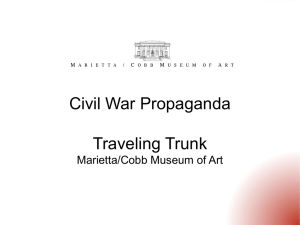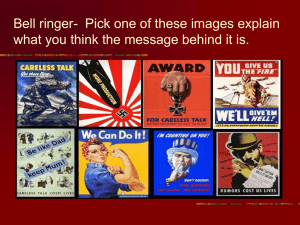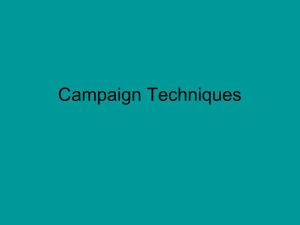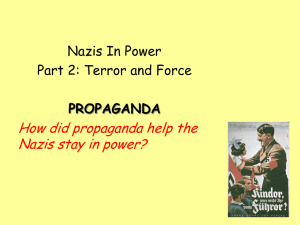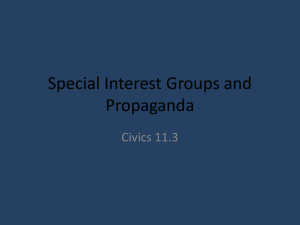High Tech Honors Packet Final
advertisement
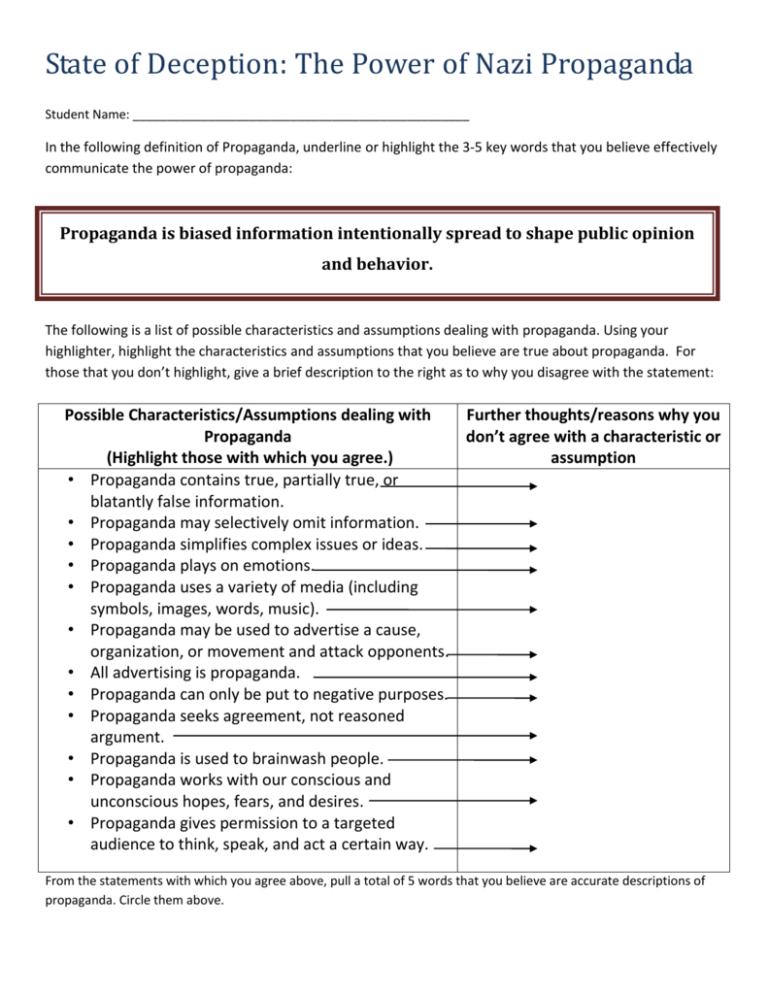
State of Deception: The Power of Nazi Propaganda Student Name: _________________________________________________ In the following definition of Propaganda, underline or highlight the 3-5 key words that you believe effectively communicate the power of propaganda: Propaganda is biased information intentionally spread to shape public opinion and behavior. The following is a list of possible characteristics and assumptions dealing with propaganda. Using your highlighter, highlight the characteristics and assumptions that you believe are true about propaganda. For those that you don’t highlight, give a brief description to the right as to why you disagree with the statement: Possible Characteristics/Assumptions dealing with Further thoughts/reasons why you Propaganda don’t agree with a characteristic or (Highlight those with which you agree.) assumption • Propaganda contains true, partially true, or blatantly false information. • Propaganda may selectively omit information. • Propaganda simplifies complex issues or ideas. • Propaganda plays on emotions. • Propaganda uses a variety of media (including symbols, images, words, music). • Propaganda may be used to advertise a cause, organization, or movement and attack opponents. • All advertising is propaganda. • Propaganda can only be put to negative purposes. • Propaganda seeks agreement, not reasoned argument. • Propaganda is used to brainwash people. • Propaganda works with our conscious and unconscious hopes, fears, and desires. • Propaganda gives permission to a targeted audience to think, speak, and act a certain way. From the statements with which you agree above, pull a total of 5 words that you believe are accurate descriptions of propaganda. Circle them above. State of Deception: The Power of Nazi Propaganda Example propaganda analysis date: ________________ Cultural Context: 1. Who created this message and who was the intended audience? When analyzing propaganda, it is important to understand the cultural context surrounding the piece. Propaganda doesn’t just work any time, any place, with any audience since it is designed for a specific purpose. There were reasons why propaganda was effective and the ideas attractive and palatable when it was displayed. Consider why did it appear at a specific time and place? Consider the following influences to determine the cultural context of the sample piece of propaganda you are analyzing: 2. What is the purpose/message of this piece of propaganda? 3. What creative techniques were used to attract and hold attention? 4. How might different people/audiences have understood this message differently? 5. What values, lifestyles, and points of view are represented in this piece? 6. What is omitted from this message? Economy Politics Religion Education Military Family values Local, national, and world events (both past and present) 7. Which emotion(s) does this piece target? 8. What was the cultural context that influenced the attractiveness of this piece of propaganda? State of Deception: The Power of Nazi Propaganda Making a Leader Nazi propaganda experts carefully created propaganda that cast Hitler into multiple roles of military leader, politician, savior, and father of the nation. For the four images at this station, determine which role the propagandists cast Hitler in and which creative techniques they used to do so: Image 1 Image 2 Image 3 Image 4 Which role is Hitler playing? Circle one. Military Leader Savior Father of the Nation Politician Which role is Hitler playing? Circle one. Military Leader Savior Father of the Nation Politician Which role is Hitler playing? Circle one. Military Leader Savior Father of the Nation Politician Which role is Hitler playing? Circle one. Military Leader Savior Father of the Nation Politician Which creative techniques (colors, images, words, etc.) are being used to portray that role? Which creative techniques (colors, images, words, etc.) are being used to portray that role? Which creative techniques (colors, images, words, etc.) are being used to portray that role? Which creative techniques (colors, images, words, etc.) are being used to portray that role? If time permits, view the video clips of Hitler’s speeches on the laptop at your station. Video Clip Which creative techniques (lighting, music, singing, symbols, uniforms, etc.) are used to attract and hold the attention of the crowd? Page 3 of Making a Leader Theme: Hitler Campaign Speech Historical film footage link from Making a Leader: Hitler thanks members of the SA and SS Berlin, Germany, 1933 Vocabulary and Events to know for Making a Leader: Presidential Elections of 1932: Hitler was a leading candidate for President in 1932, running on the platform that he would put the country’s 6 million unemployed back to work and unite all non-Jewish Germans to restore national pride. Hitler received 30% of the vote and President Hindenburg received 49%, which meant a run-off election was necessary. In the run-off election, Hitler received 36% of the vote, while Hindenburg received 53%, giving him the clear majority. (USHMM.org) Standard Bearer: someone who carries a banner or flag; a leader of an organization, movement, or party (Merriam-Webster.com) Wolf-Cub/Junior Hitler Youth: boys from the ages of 10-14 could join the Junior Hitler Youth or Jungvolk (USHMM.org) Reich: empire, realm, nation (Dictionary.com) 1934 Public Referendum: 17 days after President Hindenburg’s death, Hitler held a public referendum to merge the offices of President and Chancellor to give him supreme power, which an overwhelming majority of the German people approved. (USHMM.org) Rallying the Nation From 1919-1929, no single German political party was able to establish a majority in parliament. Therefore, when the Nazi propagandists claimed to represent all non-Jewish Germans and promised to unite the country and put the six million unemployed Germans back to work, Hitler received massive popular support. Poster 1: What values, lifestyles, and points of view are represented in this message? Pay attention to the different hands in the poster and what they might symbolize. Poster 2: Which creative techniques (colors, words, images) are used to portray the desperation of the family in this poster? Be specific in your description. Poster 3: What was the intended message of this propaganda photograph? What cultural context (religion, education, economics, etc.)influenced the creation of this piece? Poster 4: Which emotions are targeted by this piece of propaganda selling the necessity of the war? How are these emotions communicated through color and language? If time permits, look at the Interactive Activity of the Aryan Family on page 3 of the Rallying the Nation theme: Give at least one example of how the families in all three posters are similar. How is the family in the last poster to How are American families portrayed the right different from the other two in propaganda and the media today? How is it different than the messages posters? in these pieces? Vocabulary and Events to know for Rallying the Nation: April 10, 1938: a vote was held to approve the union of Germany and Austria retroactively, since German troops had already entered Austria on March 12, 1938. The vote was manipulated to show that 99% of Austrians wanted the union, though Jews and Roma were not allowed to vote and the ballot was printed so that Ja (Yes) was printed in big circle and nein was printed smaller. The voter’s name and address was also printed on the back of the ballot. (USHMM.org) Bolshevism: Russian Communism, advocating the immediate and forceful seizure of power by the working class (Dictionary.com) Defining the Enemy The Nazis used propaganda to exclude specific groups from their society, groups whom they believed did not promote the ideals of an Aryan Germany. These groups included Jews, Roma/Sinti, Jehovah’s Witnesses, homosexuals, mentally and physically handicapped, and anyone who was seen as not supporting the Nation. In images at this station, how does each piece of propaganda define an enemy of the Nazis? Image 1 Image 2 Image 3 Image 4 Who is the enemy? Who is the enemy? Who is the enemy? Who is the enemy? Why? Use specific evidence from the propaganda. Why? Use specific evidence from the propaganda. Why? Use specific evidence from the propaganda. Why? Use specific evidence from the propaganda. If time permits, use the laptop at your station to listen to the two survivors speak about their exclusion from German society during this time period. You can find these testimonies on Page 2 of the Defining the Enemy theme under Voices of the Excluded. Name of Survivor How did each survivor react to their exclusion from society? Summarize their reaction below in your own words or in a quote from the survivor. BOB BEHR GUY STERN Vocabulary and Events to know for Defining the Enemy: Shrove Tuesday (Fastnacht): the last day of Shrovetide, the three days before Ash Wednesday. Shrovetide is the season of merrymaking before Lent, an annual season of 40 days of fasting before Easter (Dictionary.com) Voracious: craving or eating large quantities of food (Dictionary.com) Reichsmark: the money of Germany from 1924-1948 (Dictionary.com) Deemed: to form or have an opinion; judge; think (Dictionary.com) Unfit: unqualified or incompetent (Dictionary.com) Allegedly: to declare without proof as before a court (Dictionary.com) Illicit: not legally permitted or authorized; disapproved of or not permitted for moral or ethical reasons (Dictionary.com) Defiler: to make foul, dirty, or unclean (Dictionary.com) Caricature: a picture or description ludicrously exaggerating the peculiarities of the defects of persons or things (Dictionary.com) Warmonger: a person who supports, endorses, or tries to bring about war (Dictionary.com) Indoctrinating the Youth Why would any society want to indoctrinate its youth? The Nazi party saw Germany’s Aryan youth as critical to the propagation of Nazi ideology. They were included and hailed as important members of German society. Analyze the four images at this station to answer the following questions: What values and lifestyles do the Nazis want their youth to adopt through the messages sent in each piece of propaganda? Image 1 Image 2 Image 3 Image 4 Give one example of how the Nazis appealed to their youth through propaganda? Which piece is the most appealing and why? __________________________________________________________________________________________________ __________________________________________________________________________________________________ If time permits, view the video of the League of German girls rally on page 4 of the Indoctrinating the Youth theme on the laptop provided at your station. What is the English translation of the phrase spelled out in the crowd of girls (Hint: look to the right of the video at the explanation)? __________________________________________________________ Why is this phrase significant? _________________________________________________________________________ __________________________________________________________________________________________________ Which creative techniques (singing, music, colors, lighting, etc.) are used to appeal to the youth at this rally? __________________________________________________________________________________________________ __________________________________________________________________________________________________ Vocabulary and Terms to know for Indoctrinating the Youth: Fuhrer: leader (Dictionary.com) “All 10-Year-Olds into the Hitler Youth”: millions of children joined the Hitler Youth before it became mandatory in 1939; boys and girls from the ages of 10-17 were required to join and participate in the Hitler Youth activities. All other competing youth organizations were dissolved at this point. League of German Girls: Girls were taught to embrace the role of mother and obedient wife in school and through compulsory membership in the Nazi League of German Girls (USHMM.org) People’s Storm/Volkssturm: in the autumn of 1944, children under the age of 16 and men over the age of 60 were put together in units to fight the enemy when they came into their hometowns. This was known as the Volkssturm, the last ditch effort to fight off the enemy. (USHMM.org) Writing the News Without a free press, the distribution of Nazi ideas both within Germany and in other countries was controlled by the Nazi government. When the Nazis came to power, there were over 4,700 daily and weekly newspapers published annually in Germany, with over 80% of them being privately owned. When free press was eliminated, only one point of view was presented in the government-owned press. Using the images displayed in this station, answer the following questions: Image 1: What is the purpose of having newspapers displayed in public cases for free? Image 2: What is the message sent by the Nazi propagandists about the People’s Radio? Image 3: How did the Nazis censor the actions of the German people? Image 4: How could listening to the radio be an act of treason? If time permits, use the laptop provided at this station to watch the video and provided commentary about the Reichstag fire. Answer the following questions: 1. How extensive is the damage from the fire (give a specific example from the film)? ______________________ ___________________________________________________________________________________________ 2. Who is blamed for the fire? What was their purpose in burning the Reichstag, according to the commentary? ___________________________________________________________________________________________ 3. How was this incident used as an excuse for Hitler to impose military law on the country? ________________ ___________________________________________________________________________________________ Vocabulary and Terms to know for Writing the News: Der Sturmer: established by Julius Streicher in 1924, Der Sturmer (The Stormtrooper) was a virulently anti-Semitic newspaper. It reached its height in circulation in 1938, but continued to be published throughout World War II. (USHMM.org) The People’s Radio: the Ministry of Propaganda heavily funded the inexpensive radio called The People’s Radio. By 1938, over 9 million of these radios had been sold, giving Germany one of the largest radio-listening audiences in the world. They could only pick up long wave radio signals, meaning that they couldn’t pick up most foreign radio stations, which were forbidden. Kristallnacht: On November 10-11, 1938, Jewish businesses, synagogues, and homes were targeted by the Nazis and their collaborators in retaliation for the assassination of the German Embassy Official in Paris, Ernst Vom Rath. Up to 30,000 Jewish men were arrested and imprisoned, 267 synagogues destroyed, and 7,500 Jewish-owned commercial establishments had their windows shattered and looted. Confiscated: to seize by authority (Dictionary.com) Traitor: a person who betrays another, a cause, or a country (Dictionary.com) Treason: acting to overthrow one’s government or planning to harm or kill its leader (Dictionary.com) Deceiving the Public Throughout World War II, Nazi propagandists disguised military aggression aimed at territorial conquest as righteous and necessary self-defense. They cast Germany as a victim or potential victim of foreign aggressors, a peace-loving nation forced to protect its populace or defend European civilization against Communism. This was propaganda of deception, designed to fool or misdirect the populations in Germany, German-occupied lands, and neutral countries. Using the laptop provided at your station, view the two staged videos in this theme meant to deceive the public and answer the following questions: Film 1: Page 3 of the theme; staged video about life in the ghettoes Film 2: Page 4 of the theme; staged video about the Terezin ghetto and the Red Cross visit Give specific staged images from the film clip: Give specific staged images from the film clip: What was omitted from these clips? Be as specific in your answer as possible. What was omitted from these clips? Be as specific in your answer as possible. What was the Nazis’ purpose in staging this film? What was the Nazis’ purpose in staging this film? Vocabulary and Terms to know for Deceiving the Public: Staged: carefully planned to produce a desired impression (Dictionary.com) Jewish Police: in the ghettos, a ghetto police force made up of Jews enforced the orders of the German authorities and the ordinances of the Jewish councils, including helping with the deportations to killing centers. They served at the command of the German authorities, and the Germans did not hesitate to kill Jewish policemen who were perceived to have failed to )carry out orders. (USHMM.org) Theresienstadt: In June of 1944, representatives from the Danish Red Cross and the International Red Cross visited Theresienstadt to inspect the ghetto’s living conditions. Many Danish Jews had been deported to the camp and the Danish government insisted on knowing how they were being treated. The three representative were shown a cleaned up ghetto with little overcrowding because 7, 503 people had been deported to Auschwitz in May of 1944 in preparation for the visit. In August and September of 1944, SS officials produced a film showing the benevolent treatment of the Jewish residents. Most of the “cast” of the film was deported to Auschwitz. Despite the effort involved in making the propaganda film, the German authorities ultimately decided not to screen it. (USHMM.org)



